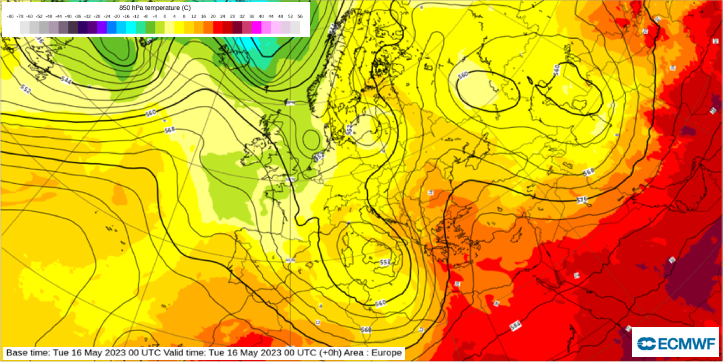
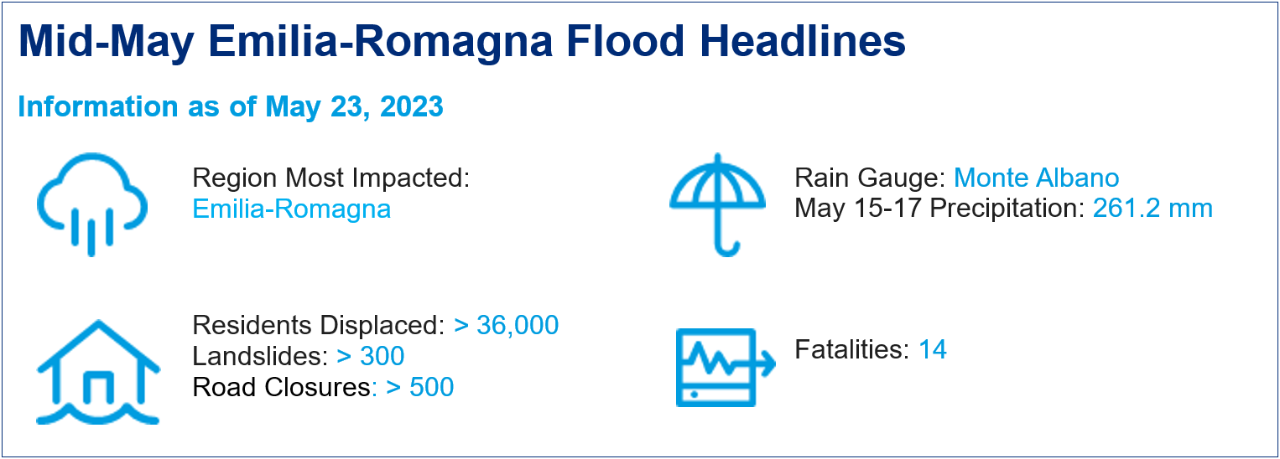
- In mid-May, extreme rainfall occurred in Emilia-Romagna, the same region that flooded earlier in the month.
- At one point during the period, the Civil Protection Department reported 36,000 residents relocated—among the largest numbers reported for flood events in the prior 20 years.
- Affected cities extended south and east from Bologna to Imola, Castel Bolognese, Faenza, Lugo, Forli, and Cesena; as well as the coastal cities of Ravenna, Rimini, and Riccione along the Adriatic Sea.
- Flooding closed access to certain areas, and airlifts were required to rescue residents.
This Mid-May Emilia-Romagna Flood post-event report comprises 3 sections:
- Hydro-Meteorological Discussion
- Industry Loss Impacts
- Portfolio Loss Estimates
Hydro-Meteorological Discussion
It is not uncommon for atmospheric disturbances to cross the Italian peninsula in spring, but they normally produce moderate precipitation and pass relatively quickly. What made the May 15-17 cyclone different were 4 characteristics: its intensity, North African genesis, unusual latitudinal (rather than longitudinal) movement, and persistency over the Italian Peninsula.
An intense and deep cyclone first arose over Algeria. It generated strong winds (indicated in green on the surface map of Figure 1), which intensified river flooding. The cyclone carried warm and saturated air from the Mediterranean as it travelled northward. When its strong winds met the Apennines, rain production was boosted by the orographic effect of the mountains. The storm then moved slowly over the country, accumulating large amounts of rainfall in river catchments.
Figure 1: Surface pressure (contours) and wind speed (color shading) at 2 a.m. local time, May 16, 2023.
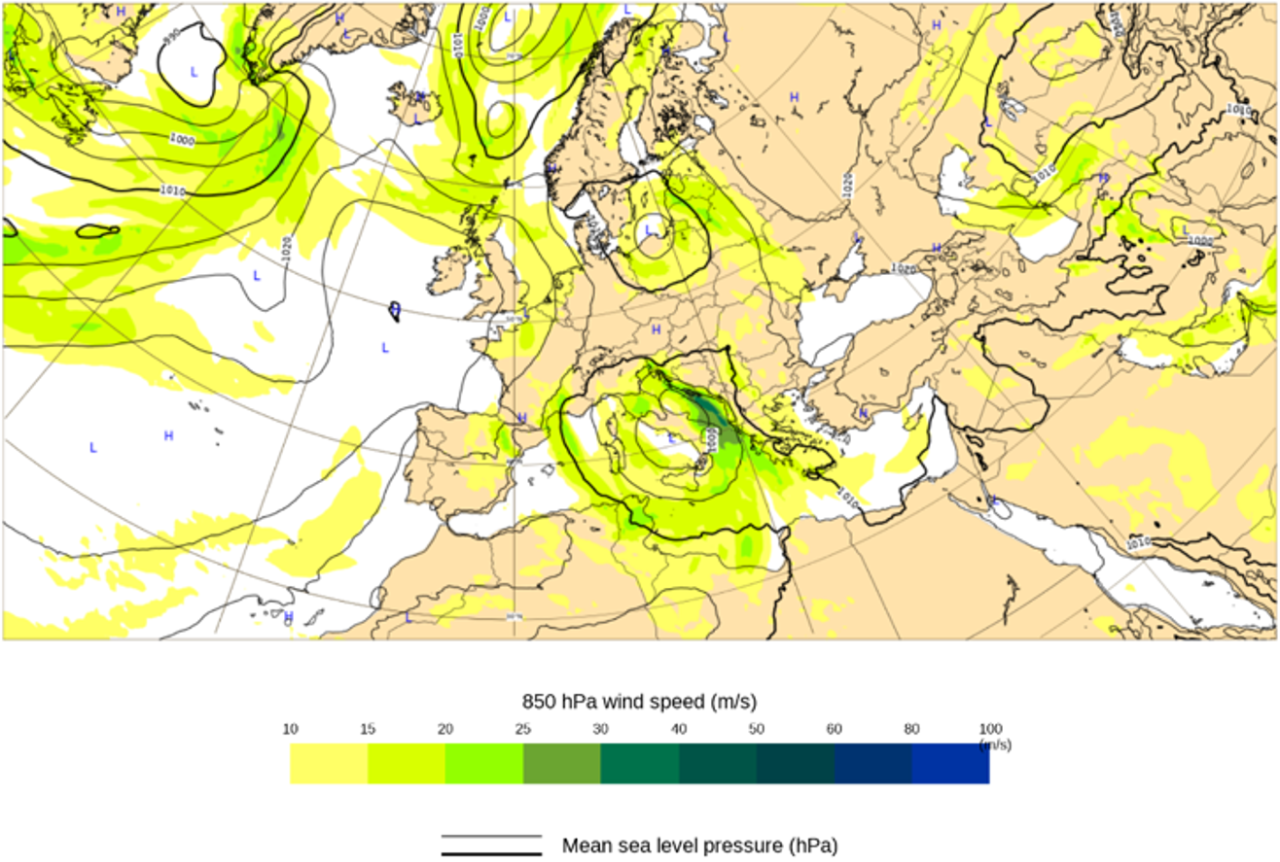
Source: European Center for Medium Weather Forecast (ECMWF)
In addition to the intense rainfall, 2 factors aggravated damage from these floods. First, much of the affected areas had been flooded earlier in the month, leaving the soil highly saturated. This resulted in much more rapid and intense run-off. Figure 2 indicates soil saturation levels prior to the early- and mid-May floods. Second, strong offshore winds resulted in higher local sea levels, which limited the capacity of river systems to discharge. The resulting floods also caused damaging landslides.
Figure 2: Soil water index (SWI) prior to the early and mid-May floods of 2023.
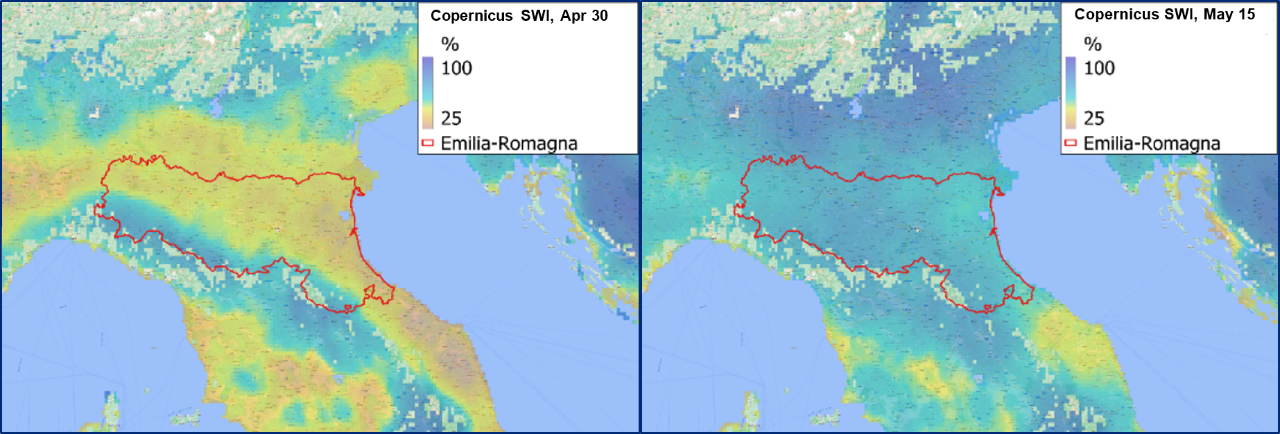
Source: Copernicus/Graphic: Guy Carpenter
Industry Loss Impacts
The mid-May floods impacted the lower Emilia-Romagna region, spanning all the way from Modena to Rimini. As of May 23, 14 fatalities were confirmed and 36,000 people were relocated to alternative accommodations: 27,000 in the Ravenna area, 4,830 in the province of Forli-Cesena, and 4,012 in the Bologna region. In addition, there were 305 landslides, and 500 roads totally or partially closed. The cities of Bologna, Imola, Castel Bolognese, Faenza, Lugo, Forli, and Cesena were heavily inundated, as were the coastal cities of Ravenna, Rimini, and Riccione along the Adriatic Sea. Figure 3 shows the cumulative precipitation in the impacted areas. The 2023 Emilia-Romagna Grand Prix, scheduled over the weekend of May 19-21 at Imola, had to be cancelled.
Figure 3: Cumulative precipitation (mm), May 15-17, 2023.
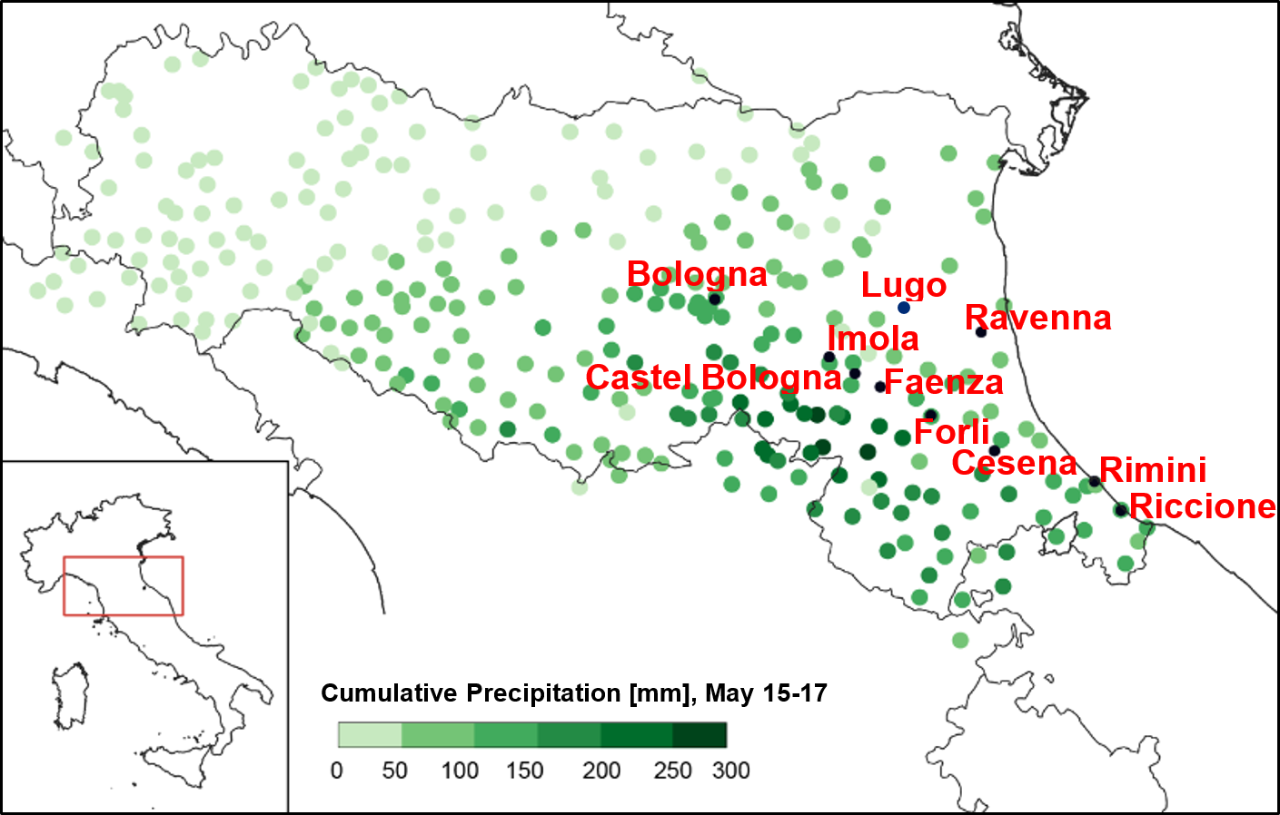
Source: ARPAE Emilia-Romagna / Graphic: Guy Carpenter
Property
Flood protection is an optional and itemized coverage in Italian property insurance policies. The latest Trends—catastrofi naturali report by Associazione Nazionale fra le imprese Assicuratrici (ANIA) indicated that less than 5% of all housing units had added flood coverage, in varying degrees by region. The country’s northern regions tend to favor the additional purchase more than those in the south. Among commercial risks, more than 90% of insured locations for large enterprises (those with more than 250 employees and/or with an annual turnover exceeding EUR 50 million) obtain flood coverage. This percentage tends to decrease with the size of an enterprise—and at the lower end, only about 3% of insured locations micro enterprises (those with fewer than 10 employees and/or an annual turnover below EUR 3 million) are covered.
Motor
Some motor vehicles were submerged during the flood, but most were not insured for flood damage. Although purchasing motor vehicle third-party liability insurance is compulsory, coverage for flood or other natural events is optional. About 15% of policies include protection against any type of natural catastrophe.
Agriculture
Emilia-Romagna is an important contributor to Italy’s agricultural production. Coldiretti, Italy’s national federation of farmers, reported that 5,000 farms were submerged, with damage to orchards, vegetables, vineyards, beehives, crops, poultry, and cattle. Warehouse grains also were affected. Losses to both crops and livestock were substantial. Confagricoltura and Cia-Agricoltori Italiani estimated over EUR 1.5 billion in damages from Forli and Cesena alone. This does not include ancillary damages to machines and lost revenue from future years.
In Italy, insurance flood coverage penetration is low. Therefore, a large portion of rebuilding costs will be absorbed by residents, business owners, and government at the local and national level. Additional resources also may come from the European Union Solidarity Fund.
Portfolio Loss Estimates
Property portfolio losses can be estimated shortly after flooding by considering the rainfall intensity from precipitation data. This information is available from the Agenzia Prevenzione Ambiente Energia Emilia-Romagna (ARPAE) and Meteo ASSAM Regione Marche. Based on each recording station’s maximum daily precipitation over the May 15-17 period (Figure 4), Guy Carpenter assessed the associated damages using our proprietary GCAT Italy Flood model. Then, coupling a portfolio’s geographical distribution of risks, we derived estimates for its insured loss.
Figure 4: Maximum daily precipitation (mm/day), May 15-17, 2023.
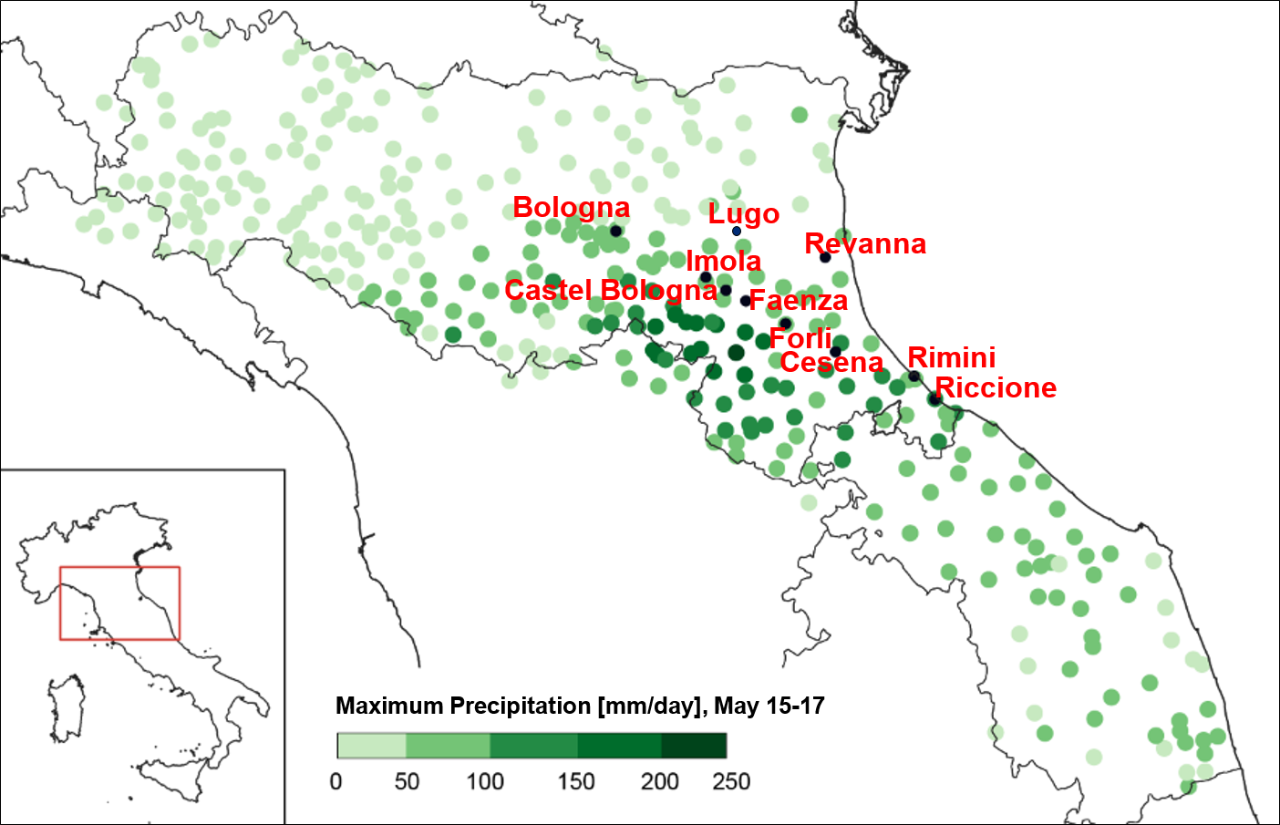
Sources: ARPAE Emilia-Romagna, Meteo ASSAM Regione Marche / Graphic: Guy Carpenter
When flood footprints from Geospatial Insight, Copernicus, JBA and RMS became available in the week following the event, Guy Carpenter evaluated their qualities. We then built custom scenarios for use in our GCAT Italy Flood model to estimate losses. Flood footprints varied greatly, with some much better in more populated areas, and others good in most areas but weaker in valleys. Some footprints had been aggregated from multiple sources, and indicated excessive amounts of flooded area if not carefully interpreted.
Client results ranged from a 5-to-10-year return period to 20-to-35-year return period, with the median around a 10-to-20-year period. Based on our portfolio analysis, insured property losses for the industry will be in the region of EUR 500 million or more and could reach as high as EUR 1 billion. Applying the same method to motor vehicles produced an additional 10-15% in property insurance loss estimates. Crop losses may be substantial and are difficult to assess. Local farmers continue working to stem the losses.
Damages from the latest floods will add to inflationary pressures in Italy’s economy, especially in food prices. The global market for automobile parts, as well as used and new motor vehicles, is already under stress, and the additional demand from these floods will amplify the problem. Given current global economic uncertainties, ultimate costs from the floods are likely to depend heavily on the time required for reconstruction.
Sources: European Centre for Medium-Range Weather Forecast (ECMWF), Copernicus, Dipartimento della Protezione Civile, Coldiretti, Auto Sports, Agenzia regionale per la prevenzione, l’ambiente e l’energie dell’Emilia-Romagna (ARPAE), Meteo Regione Marche, Associazione Nazionale fra le imprese Assicuratrici (ANIA), BNN Bloomberg, Foodweb, Sky TG24